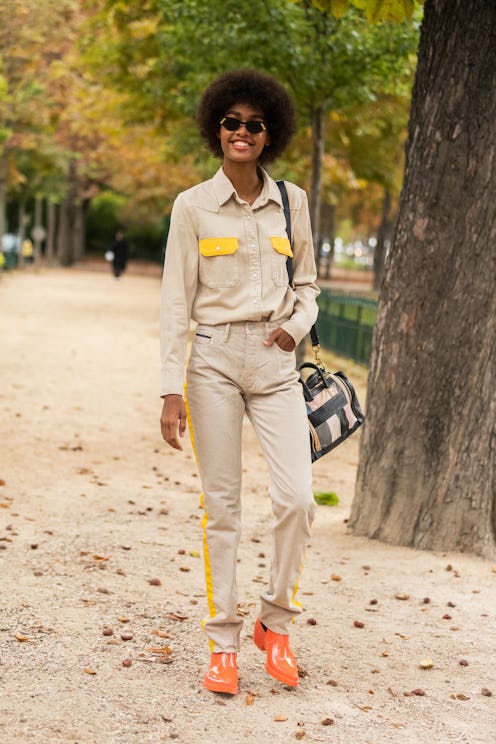(Fashion)
Athleisure Isn't Going Away — It's Just Turning Into *This*

What The Frankie Shop, a small but mighty women’s clothing store in Manhattan’s Lower East Side neighborhood, lacks in physical presence, it makes up for in its inventory. The shop stocks a curated selection of refined but trendy tailored pieces, knits, and accessories, luring downtown shoppers whose idea of what comfortable, functional items is more button-down cargo shirt than joggers. But is this a sharp turn away from the athleisure trend in 2020?
“Women come to Frankie for a very specific aesthetic,” says founder Gaelle Drevet. As fashion’s pendulum swings, it’s that refined aesthetic that’s tipping the scales away from streetwear's omnipresence towards a more refined take on everyday dressing. But it's not necessarily a marked departure from casual, cool comfort — it's an evolution.
The streetwear hype pieces that dominated street style a few years ago no longer resonate in the same way — the oversized Yeezy Boost, Fila Disruptor, and Balenciaga Triple S sneakers now feel a bit clumsy. While the casualization of your closet is hardly a fluke left behind in the 2010s — Lululemon posted record profits over the most recent holiday season — designers, for their part, are looking for a path forward from the athleisure craze that ate up so much space in fashion for the better part of a decade.
Referencing both the fit and flare silhouettes of the '70s, and the power suiting of the '80s, designers that once championed sweats are adding a bit more structure. At Balenciaga and Bottega Veneta alike polished suiting has reemerged as the aesthetic of choice for those interested in ditching the all-casual hoodie.
Even designers that championed the hypebeast economy, like Virgil Abloh, are now prophesying its end. Abloh told Dazed in December, “I would definitely say [streetwear’s] gonna die, you know? Like, its time will be up,” he said. “In my mind, how many more T-shirts can we own, how many more hoodies, how many sneakers?” A month earlier, Another influential creative director, Kim Jones of Dior, suggested we retire the term “streetwear” altogether.
Of course, there are those designers who never bothered with hype products for the sake of sales at the expense of aesthetic dilution. The Row is perhaps the most notable example of a never-wavering commitment to polished minimalism. For Pre-Fall 2020, the brand offered a few dozen garments marked by relaxed tailoring — double-breasted blazers and peacoats, styled above vaguely vintage button-downs and turtlenecks. “We’re not a trend-driven business,” Mary-Kate Olsen, one part of the duo behind The Row, told Vogue in January. “Everything here is reimagined from something. It’s pretty practical. We try to make sure it has consistency because our clients rely on us.”
Meanwhile, Peter Do’s take on the self-assured woman is one who is as comfortable wearing a leather bolero jacket as she is a fire-hydrant red pleated trouser, both of which the designer prescribed for Spring 2020. Over at Gabriela Hearst, the designer put forth a more relaxed, feminine silhouette for the upcoming season, characterized by belted waistlines over linen blazers and collared shirt-dresses — comfortable, though nary a sneaker or hoodie in sight.
Retailers, too, are taking note of the aesthetic shift toward polish. Menswear e-tailer Mr. Porter stocked more tailored garments in the fourth quarter last year in categories like blazers and button down shirts, while reducing its investment “dramatically” in athleisure categories like T-shirts, sweatpants, and sneakers, according to retail analytics platform Edited. In womenswear, Farfetch increased its suiting options nine percent in the last quarter of 2019, while Bergdorf Goodman and Neiman Marcus expanded their offerings with women’s new-in suit jackets up 25 percent and 126 percent, respectively.
But, even as aesthetics shift, there's one particularly important aspect of streetwear that persists: the growth and success of the “drop” model, in which brands release a product in a limited run outside of the traditional retail schedule. Rihanna’s Fenty has put to use the drop model, as has Moncler for its “Genius” project and Burberry in partnership with e-comm site Mytheresa.
"We love to offer things that are exclusive to Mytheresa, as this differentiates us from our competitors but also creates a hype due to limited availabilities," explains Tiffany Hsu, the e-tailers fashion buying director. "When something is exciting and new with a high participation and more of a 'fashion-in-the-know' item or brand, only customers who are super savvy will follow the exact drop timing."
No matter what you're personal style may be, you can find yourself fighting to get your hands on something exclusive, rare, or highly coveted.
This article was originally published on